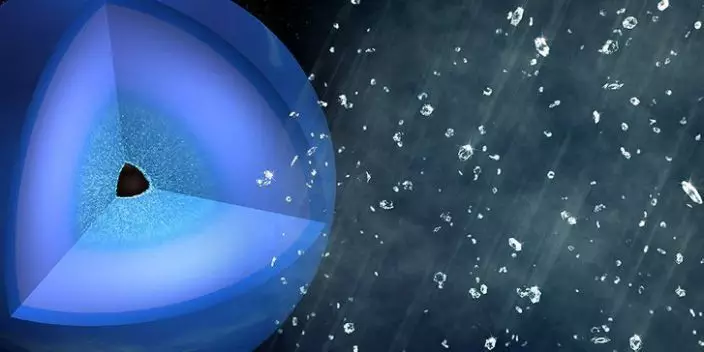
Scientists believe there may be 'diamond rain' falling on Uranus and Neptune, thanks to findings from new research.
The two planets are often referred to by astronomers as 'ice giants' due to their rocky, icy cores, but deep inside their temperature and pressure are so high that astounding physical reactions could be taking place.
The new findings, which were published in Nature Communication, came after researchers used the US Department of Energy's National Accelerator Laboratory (SLAC) Linac Coherent Light Source (LCLS) to explore how a hydrocarbon would behave under the temperatures and pressure expected to be found 10,000km (6,200m) inside Neptune.
Advert
The team conducted experiments at the SLAC National Accelerator Laboratory at Stanford University to better understand the molecular magic happening on such planets, recreating the diamond rain found within Neptune's core.
They used hydrocarbon polystyrene, which is also known as Styrofoam, in place of the methane that would be found inside the ice giants.
Physicist and lead author Dominic Kraus, of the Helmholtz-Zentrum Dresden-Rossendorf research institute in Germany, said in a press statement: "Our experiments are delivering important model parameters where, before, we only had massive uncertainty.
"This will become ever more relevant the more exoplanets we discover."

According to Popular Mechanics, Kraus and his team applied heat and pressure to the hydocarbon polystyrene, using a laser to create shockwaves that prompted temperatures to soar to 4,730 °C (8,540 °F).
Advert
The hydrocarbons split into their elemental constituents, with the hydrogen escaping the the carbon rapidly converting to diamond and sinking - with Kraus saying the experiment could prove why Neptune's core produces such bizarre levels of energy.
Kraus added: "In the case of the ice giants we now know that the carbon almost exclusively forms diamonds when it separates and does not take on a fluid transitional form."
LCLS Director Mike Dunne said in a statement: "This research provides data on a phenomenon that is very difficult to model computationally: the 'miscibility' of two elements, or how they combine when mixed.
"Here they see how two elements separate, like getting mayonnaise to separate back into oil and vinegar.
Advert
"What they learn could offer insight into a key way fusion fails, in which the inert shell of a capsule mixes in with the fusion fuel and contaminates it so that it doesn't burn."
Featured Image Credit: Helmholtz-Zentrum Dresden-Rossendorf